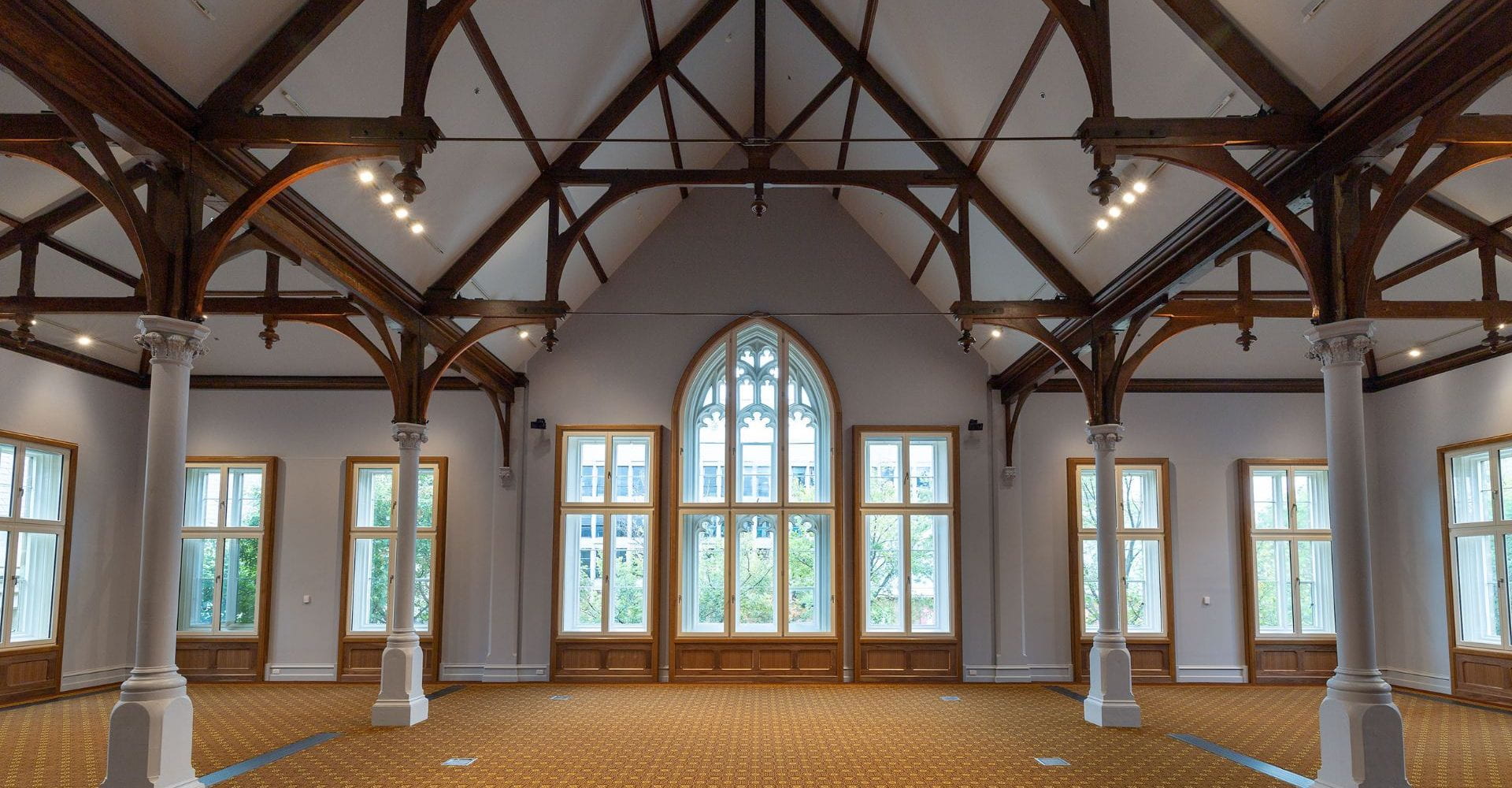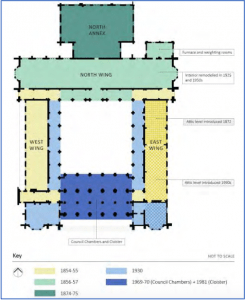
An unexpected discovery: Peeling back the layers in the Old Quad
During the refurbishment of Old Quadrangle’s North Annex from 2017 to 2019, the architecture of the original library was revealed along with two pieces of linoleum flooring (‘lino’). The Old Quadrangle (Quad) is the first building on the University’s Parkville campus, constructed from 1854 -1857, and consists of three wings and an annex forming the core of the present campus. Far from its presentation as an unchanging stone edifice, the Old Quad is architecturally significant. It is not only a vivid presentation of the University’s close link with British universities in the mid-nineteenth century, but also socially as it accommodated and nurtured social and intellectual interactions between the academy and the students[1]. The Old Quad has witnessed the growth and the evolution of the University’s Parkville campus and provides a tangible connection to the University’s fledgling years.
Image 1: The Sequential development of the Old Quadrangle: core phases, Lovell Chen, 2017
The discovery of the historic lino flooring is unexpected. Invented by Englishman Frederick Walton in 1860, lino flooring was the first form of waterproof floor covering to replace more conventional bare wood or dirt floors[2]. The retrieved lino pieces are dark brown in colour and were designed in yellow/gold geometric patterning with a burlap textile adhered to the back of each piece. These relics reflect the design conventions that were once popular during 19th Century Melbourne. The aim of Old Quad’s renovation project is to largely return the building’s floorplan to its original layout, reaffirming Old Quad’s place as the cultural, civil, engagement and ceremonial centre of the Parkville campus[3]. One of the ways this is achieved in the design is to incorporate the gold and black motif into the overall carpet design in both stories of the building.
Image 2: Discovered lino piece, Yuhong Zhang, 2019
The design team had hoped to exhibit the two lino fragments in the Old Quad after renovation as the fragments were in fair condition when discovered. However, after being used and buried under the ground for such a long period of time, each piece has small holes, multiple abrasions, and were roughly cut with a split along the straight edge of the larger piece. It is evident that these two fragments had suffered from surface dirt and structural damage (cracks), and required immediate treatment. Therefore, they were later transported to the Grimwade Conservation Services to regain their structural integrity and were installed into the display.
One of the biggest challenges for the conservation and exhibition design team is that there is no precedent regarding conserving and displaying lino flooring that conservators and curators could consult. Based on their experience on previous projects, object and paper conservators decided to stabilize, clean, and then attach two pieces to double-wall boards for display purposes. Considering the material composition of the objects, slightly diluted fish glue was used to stabilize the cracks. After the glue dried and its residue removed by warm water, the lino surfaces were cleaned using damp cotton swab rolled on bamboo sticks and in light circulation motions. After above steps, there was still a small portion protruding from the top corner on the back of the larger lino piece. In this case, Japanese tissue paper was selected to adhere to that small portion for reinforcement. Japanese tissue paper with its superb qualities of strength and durability quality has been used as a support material for a long time[4].
Images: White Tyvek tape & hinging demonstration, Yuhong Zhang, 2019
As for the display design, the two pieces of lino flooring will be attached to two double-wall blue-boards respectively and then placed together onto a new white mount board into the showcase. Heavyweight Japanese kozo paper were cut into wide strips as hinges. They were then adhered to the back of the bigger lino fragment equidistantly using fish glue. A piece of blue double-wall corrugated board was cut to a smaller profile than the lino pieces. To avoid visual distraction, white Tyvek tape was used to seal board edges. Slots were later cut through the blue board and there were hinges pulled through and adhered back down using starch paste. The lino pieces with their supporting blue boards were attached to a white mount board using double-sided tape, which was then attached to a acrylic backing board using double-sided tape.
The Old Quad’s implementation project focused on the adaptation and refurbishment of the North Wing, the north end of the East Wing and the North Annex. Significantly, this project is the first application in Australia of the adaptive passive house principles and introduced an innovative sustainability scheme to help a heritage building meet the requirements of the 21st century[1]. The Old Quad is one of the finest and oldest non-ecclesiastical gothic revival structures in Victoria[2]. And now it becomes a highly efficient and low energy cost building. This project sets up a good example for universities and heritage societies who want to protect their heritage and history through refurbishment and reutilization. Mehmet Murat Ildan once said, “Every time the long-forgotten people of the past are remembered, they are born again!”. The way that the design team tried to reinstate the original planning, conserve fabric and details, and display old lino fragments respect the layers of history of one of the University’s most important buildings.
Yuhong Zhang
The author would like to thank Libby Melzer, Peter Mitchelson, Dr Evan Tindal, and Jordi Casasayas from Grimwade Conservation Services for their kind support and guidance during the housing process, and for sharing their conservation knowledge and treatment steps for this article.
[1]Chen 2017, pp.4-6
[2] Petrovi ́c 2016, p.165
[3] Aurencon 2019
[4] Mills 1988, p.31
Feature image: Interior, Old Quad, photograph by Christian Capurro
Categories
- Uncategorised
- Special Collections




Cool!